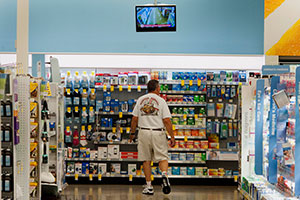Consumer Spending Drops by Most in Five Years

Consumer spending fell in December as households took a breather from the break-neck pace of buying that characterized the fourth quarter.
Household purchases declined 0.3%, the biggest decline since September 2009, after a 0.5% November gain, Commerce Department figures showed Feb. 2 in Washington. The median forecast of 68 economists in a Bloomberg News survey called for a 0.2% drop. Incomes and the saving rate rose.
Consumers responded to early promotions by doing most of their holiday shopping in October and November, leading to the biggest jump in consumer spending last quarter in almost nine years. For 2015, a pick-up in wage growth will be needed to ensure households remain a mainstay of the expansion as the economy tries to ward off succumbing to a global slowdown.
“Consumption ended on a softer note, but it’s important to think about the quarter in whole, and we know October and November were good months,” Tom Porcelli, chief U.S. economist at RBC Capital Markets in New York, said before the report. “With the improvement we’ve seen in energy prices and the improvement we’ve seen in confidence, that all suggests it’s reasonable to hold a constructive view on spending over the course of 2015.”
Projections for spending ranged from a decline of 0.6% to a 0.2% gain. The previously month’s reading was initially reported as an increase of 0.6%.
Incomes climbed 0.3% in December for a second month, the Commerce Department’s report showed. The Bloomberg survey median called for a 0.2% increase. November’s income reading was revised down from a 0.4% gain previously reported.
While growth in the world’s largest economy slowed in the fourth quarter, consumption surged, with household spending rising at the fastest pace since early 2006, a report from the Commerce Department last week showed.
Gross domestic product climbed at a 2.6% annual rate from October through December after a 5% pace in the third quarter, the report showed. Cheaper gasoline and labor market improvement helped consumption grow at a 4.3% rate, the biggest since 2006, though business investment cooled amid plunging oil prices and concerns that growth in overseas markets is faltering.
After adjusting for inflation, which generates the figures used to calculate GDP, purchases dropped 0.1% in December after jumping 0.7 % the previous month, according to the report.
Spending on durable goods, including automobiles, decreased 0.7% after adjusting for inflation, following a 2.5% gain. Purchases of non-durable goods, which include gasoline, fell 0.1%.
Automobile demand was a pillar of strength for the economy in 2014, with light-vehicle sales totaling 16.5 million, the most since 2006. And after last year’s strong finish, analysts surveyed by Bloomberg raised their 2015 estimates, forecasting 16.9 million deliveries.
Those sales have been fueled in part by a drop in oil prices and the cheapest gasoline in years. The average price of a gallon of regular gasoline was $2.06 on Feb. 1, compared to the 2014 peak of $3.70 reached in April.
Expenditures on services were little changed after adjusting for inflation, the figures showed. The category, which includes tourism, legal help, health care, and personal care items such as haircuts, is typically difficult for the government to estimate accurately until more information is available in later months.
The oil-price plunge is also weighing on inflation, making it more difficult for the Federal Reserve to determine the timing of its first interest rate increase since 2006. The price index tied to consumer spending declined 0.2% in December, the Commerce Department report showed.
From a year earlier, the gauge was up 0.7%, the smalle4st increase since October 2009. This inflation measure is preferred by Fed policy makers and hasn’t been above their 2% goal since March 2012.
Stripping out the volatile food and energy components, the price measure was little changed from the month before, and climbed 1.3% in the 12 months ended December.
Central bank policy makers upgraded their assessment of the U.S. economy, saying “activity has been expanding at a solid pace,” in a Jan. 28 statement that also maintained a pledge to be “patient” on raising interest rates. “Labor market conditions have improved further, with strong job gains and a lower unemployment rate.”
Progress in the labor market has helped boost incomes, albeit slowly. Almost 3 million more people found work in 2015, the most since 1999.
Tyson Foods Inc. is among companies contributing to the improvement. The largest U.S. meat producer plans to create more than 500 jobs at its Vienna, Georgia, poultry plant amid growing demand for its products.
“In the past quarter, consumer confidence, lower gas prices and unemployment data were tailwinds that we expect will continue to favor food spending in the New Year,” Chief Executive Officer Donald Smith said on a Jan. 30 earnings call. “But pressures like long-term unemployment and limited wage growth still weigh on a lot of people.”
Disposable income, or the money left over after taxes, increased 0.5% in December from the prior month after adjusting for inflation.




